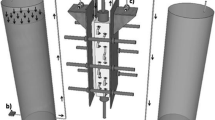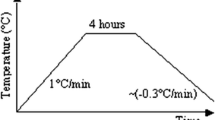Abstract
Ultra High Performance Fiber Reinforced Concretes (UHPFRC) present outstanding mechanical properties and a very low permeability which make them very attractive for the rehabilitation of existing structures and for new conceptions. UHPFRC are characterized by a significant tensile strain hardening (multiple cracking stage) that can be used to optimize the mechanical performance of composite structural elements. In order to validate this assumption, permeability tests were carried out on UHPFRC specimens previously submitted to various levels of tensile deformation with progressive damage. Based on permeability results, it was possible to define maximal tensile deformations whereby the water permeability of a specific UHPFRC remains low for various exposure conditions.
Similar content being viewed by others
References
Brühwiler E, Denarié E, Habel K (2005) Ultra-high performance fibre reinforced concrete for advanced rehabilitation of bridges. In Keep Concrete Attractive, Proceedings Fib symposium, Budapest, Hungary, May, (Balasz GL, Borosnyoi A (eds.)) pp. 951–956.
Habel K (2004) Structural behaviour of elements combining ultra-High performance fibre reinforced concretes (UHPFRC) and reinforced concrete. Doctoral Thesis n 3036, Swiss Federal Institute of Technology, Lausanne, Switzerland.
Rossi P, Parant E, Laurence O, Fakri P, Arca A (2002) Comportement mécanique d'un nouveau composite cimentaire à écrouissage positif. Bulletin des Laboratoires des Ponts et Chaussées (238) 25–38. “Only available in French”.
Habel K, Denarié E, Brühwiler E (2005) Tensile testing and tensile strain hardening behavior of Ultra-High Performance Fiber Reinforced Concretes (UHPFRC). Submitted to Journal of Materials in Civil Engineering.
Ludirdja D, Berger RL, Young JF (1989) Simple method for measuring water permeability of concrete. ACI Materials Journal, 86(5):433–439.
Wang K, Jansen DC, Shah SP, Karr AF (1997) Permeability study of cracked concrete. Cement and Concrete Research, 27(3):433–439.
Aldea CW, Shah SP, Karr AF (1999) Permeability of cracked concrete. Materials and Structures, 32(219):370–376.
Kamen A, Denarié E, Brühwiler E (2005) Mechanical behaviour of Ultra High Performance Fibre Reinforced Concretes (UHPFRC) at early age, and under restraint. In ‘Concreep7,’ Proceedings of an International Conference, Nantes, France, September, 6 pages.
Reinhardt HW, Jooss M (2003) Permeability and self-healing of cracked concrete as a function of temperature and crack width. Cement and Concrete Research, 33:981–985.
Hearn N (1998) Self-sealing, autogenous healing and continued hydration: What is the difference. Materials and Structures, 31:563–567.
Stecher PG, Windholz M, Leahy DS (1968) The Merck index - Encyclopedia of chemicals and drugs, (Rahway, USA).
Reinhardt HW, Hearn N, Sosoro M (1997) Transport properties of concrete. In RILEM Report 16 - Penetration and Permeability of Concrete, (Reinhardt HW (ed.), Stuttgart) pp. 213–264.
Brühwiler E (1995) The effect of hydrostatic pressure on the fracture of concrete. University of Colorado report, Boulder, USA 154 pages.
Gérard B, Reinhardt HW, Breysse B (1997) Measured transport in cracked concrete. In RILEM Report 16 - Penetration and Permeability of Concrete, (Reinhardt HW (ed.), Stuttgart) pp. 265–324.
ACI Committee 318 (1989) Building Code Requirements for Reinforced Concrete, (American Concrete Institute, Detroit) pp. 106–108.
CEB (1993) CEB-FIP model code 1990, (Comité Euro-International du Béton) 437 pages.
BAEL (1999) Règles BAEL 91 modifiées 99 (Commission générale de normalisation du bâtiment) 333 pages. Only available in French.
SIA (2004) ‘Norme 260 - Ouvrages en béton’ (Société Suisse des Ingénieurs et Architectes). Only available in French.
Habel K, Charron JP, Denarié E, Brühwiler E (2004) Preliminary tests on bonding of reinforcement bars in UHPFRC, Internal report MCS 99.04-2.
Li VC (2002) Reflections on the research and development of engineered cementitious composites (ECC). In Ductile Fiber Reinforced Cementitious Composites (DFRCC), Proceedings of an International Workshop, Takayama, Japan, 1–21.
Author information
Authors and Affiliations
Rights and permissions
About this article
Cite this article
Charron, JP., Denarié, E. & Brühwiler, E. Permeability of ultra high performance fiber reinforced concretes (UHPFRC) under high stresses. Mater Struct 40, 269–277 (2007). https://doi.org/10.1617/s11527-006-9105-0
Received:
Accepted:
Published:
Issue Date:
DOI: https://doi.org/10.1617/s11527-006-9105-0




